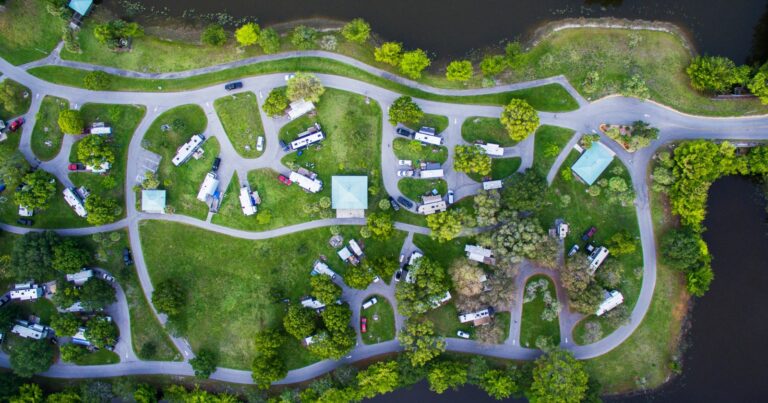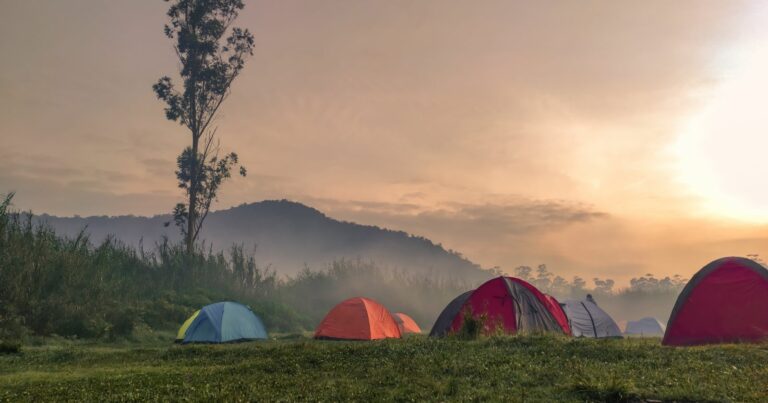How to Use a Tarp as a Canopy
A tarp is one of the most versatile items you can pack for camping. With a bit of creativity, you can transform a simple tarp into a cozy canopy that provides shade and shelter at your campsite. Whether you want protection from sun, wind, or rain, a DIY tarp canopy has got you covered.
As an avid backpacker, I’ve relied on my trusty tarp to get me through all kinds of weather on the trail. Learning how to pitch it as an overhead canopy was a game-changer! It creates an instant sheltered space wherever I need one – no trees required. And the freedom to configure it however I want makes it ideal for different conditions and groups.
In this article, I’ll share step-by-step instructions and pro tips for pitching a tarp as a canopy. With just a tarp, some paracord, and trekking poles or sticks, you’ll be able to create a cozy oasis in your campsite and customize it perfectly for your needs.
I’ll walk through how to choose the ideal tarp size and material for maximum versatility. You’ll learn proper techniques for tying off the corners and edges so your canopy stays taut and secure. I’ll also cover how to adjust the pitch and height to provide optimal shade and rain protection.
Whether you need basic sun coverage during the day or a dry hangout space for a group when it’s pouring, this article has you covered. You’ll even learn some bonus tricks for enhancing airflow and privacy too.
With the step-by-step advice I’ll share, you can quickly master the art of tarp pitching. Knowing how to turn a simple tarp into an instant canopy or shelter empowers you to camp comfortably in any conditions. This skill has gotten me through solo trips and large group camps alike.
Let’s dive in and unlock the full potential of that tarp in your gear closet! With a bit of practice, you’ll be able to pitch pro-level tarp canopies and shelters to handle whatever weather comes your way. I can’t wait to pass on what I’ve learned so you and your fellow campers can stay comfy no matter what.
Not all tarps are created equal when it comes to canopy usage. Here’s what to look for:
- Size – Larger tarps (10×10 ft or more) provide ample overhead coverage. Make sure it’s big enough for your needs.
- Thickness – Heavier-duty tarps (8-10 mil) stand up better to wind and won’t flap around.
- Material – Poly tarps are waterproof and resilient. Canvas adds breathability.
- Grommets – Metal rings allow secure ties at the corners and perimeter.
- Color – Lighter colors won’t absorb as much heat from the sun.
Select the Best Location
Pick a suitable spot to set up your tarp canopy:
- Find a flat, clear area free of debris and obstructions.
- Stay away from dead trees, hills, and rocky areas that can’t support poles.
- Pick a space with ample room around the edges for guylines.
- Consider sun orientation and aim for shade, if possible.
- Allow a safety buffer from fires or stoves to prevent accidents.
Prepare the Tarp
Take these steps to get your tarp ready for pitching:
- Shake out debris like dirt, leaves, or needles from the top.
- Check for defects like rips, mold, or missing grommets and repair if needed.
- Lay tarp flat in approximate position, with corners pointed toward planned pole locations.
- Weigh down edges with rocks or gear to keep it in place until raised.
Set the Poles
Install poles at the corners to lift the tarp:
- Use trekking poles, strong sticks, PVC pipe, or 2×4 posts cut to desired height.
- Position a pole at each corner grommet extending the pole tip through the ring.
- Loosely attach the poles to the grommets initially with a cord until raised.
- Space poles wide enough so tarp doesn’t sag much in the middle when raised.
Lift Into Position
Once the corners are set up, hoist the tarp into a canopy:
- Recruit help to lift all 4 poles simultaneously to keep it even.
- Raise to desired height, around 7-8 ft for comfortable standing room.
- Firmly secure each pole to the grommet with a tight knot once up.
- Adjust corner heights as needed to get the tarp taut and flat.
Secure the Edges
Further stabilize the canopy by tying off all sides:
- Attach guylines at intervals along the edges from pole to pole.
- Stake guylines down well on outward angles to create tension.
- For very windy areas, add lines from the pole tips staked at 45° angles too.
- Reinforce the pole connections with extra wraps of cord, for redundancy.
Customize the Pitch
You can adjust the pitch and shape of the tarp as needed:
- Pitch it at a steep angle for optimal rain protection.
- Go with a shallow pitch to maximize headroom underneath.
- Pull opposite corners down to make a covered ridge area.
- Keep the sides open for airflow or close them up to block wind.
Add Convenience Features
Personalize your canopy to suit your needs:
- Use gear like packs or coolers to hold down edges instead of stakes.
- Attach mesh interior walls between poles for bug protection.
- Add insulating interior sides to keep heat in during cold weather.
- Run an electric or solar light along the ridgeline for nighttime illumination.
- Hang curtains from the edges for improved privacy and ambiance.
Practice Proper Takedown
When it’s time to pack up, follow these tips:
- Remove any accessories or add-ons you’ve installed first.
- Carefully collapse poles inward to bring the tarp down smoothly.
- Make sure the tarp is completely dry before folding to prevent mildew.
- Fold from each side first, then roll tightly from head to foot.
- Store tarp in a dry location away from rodents that may chew holes.
With a quality tarp and a bit of skill, you can create an instant campsite canopy customized to your exact needs. Use these techniques to provide shade, shelter, and an extra spacious feel at your next outdoor adventure!







